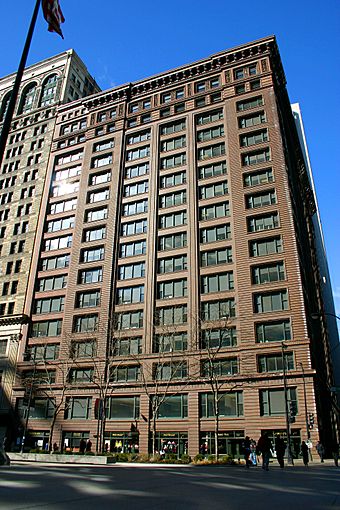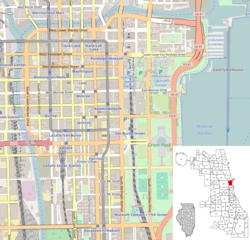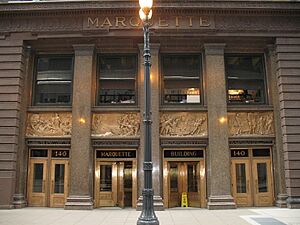Marquette Building (Chicago) facts for kids
|
Marquette Building
|
|

Marquette Building at the northwest corner of Dearborn St. and Adams St.
|
|
| Location | 140 South Dearborn Street Chicago, Illinois |
|---|---|
| Area | 0.8 acres (0.32 ha) |
| Built | 1895 |
| Architect | Holabird & Roche |
| Architectural style | Chicago |
| NRHP reference No. | 73000697 |
Quick facts for kids Significant dates |
|
| Added to NRHP | August 17, 1973 |
| Designated NHL | January 7, 1976 |
The Marquette Building is a famous building in Chicago, Illinois. It was finished in 1895 and designed by architects Holabird & Roche. Today, it is owned by the John D. and Catherine T. MacArthur Foundation. You can find it in a part of Chicago called the "Loop".
This building was one of the very first skyscrapers to use a steel frame, which was a new and exciting way to build tall buildings back then. It's also seen as one of the best examples of the Chicago School of architecture. The outside of the building was originally a reddish color, made from a material called terra cotta.
The Marquette Building has won many awards and honors since it was built. It became a Chicago Landmark in 1975. It was also added to the National Register of Historic Places in 1973 and named a National Historic Landmark in 1976. The building was carefully restored between 2001 and 2006.
Building History
The Marquette Building is named after Father Jacques Marquette. He was an explorer who visited the Chicago area in 1674. He even spent the winter there from 1674 to 1675. The building was designed by William Holabird and Martin Roche, who were part of the firm Holabird & Roche.
In the 1930s, the building was a main office for more than 30 different railroad companies. Around 1950, a decorative part called the terra-cotta cornice was taken off. This happened when another story was added to the building. The Marquette Building has always been used as an office building since it was first built.
In 1977, a company owned by John D. MacArthur bought the building. After he passed away in 1978, the building became the main office for the MacArthur Foundation. This foundation is named after him. The lobby of the Marquette Building connects to another building, creating an indoor walkway. This walkway lets people walk from Dearborn Street to Clark Street.
Amazing Architecture
The Marquette Building has many special features that make it famous. It is a great example of the Chicago School of Architecture. The architects used "Chicago windows," which are very long, horizontal windows. These windows have a large main glass pane with narrow windows on the sides.
The building is 16 stories tall. Its strong steel frame allows for walls that don't carry weight, which means they can have many windows. The outside of the building has wavy designs and is made of brown terra cotta. Inside, the building has a beautiful two-story lobby with a central open space called an atrium.
The lobby and entrance of the Marquette Building are decorated with mosaics, sculptures, and bronze. These artworks tell the story of Jacques Marquette's expedition in 1674-1675. Four special panels above the main entrance show different parts of Marquette's journey. These panels were made by sculptor Hermon Atkins MacNeil.
The revolving doors have carvings of panther heads. Around the lobby's open space, there's a railing decorated with a mosaic frieze. This mosaic was made by the Tiffany studio. It shows events from Jacques Marquette's life, his exploration of Illinois, and the Native Americans he met. The mosaics use colorful Tiffany glass, mother-of-pearl, and shiny stones.
Building Restoration
The Landmarks Preservation Council of Illinois worked hard to save this important building. In 2001, the John D. and Catherine T. MacArthur Foundation, who own the building, started a big renovation project. The outside of the building was restored in two main steps. First, the cornice was rebuilt, and the 17th-story windows were replaced to look like the originals. Then, the stone work was cleaned and fixed, and the rest of the windows were restored. Architect Thomas "Gunny" Harboe led this work.
In 2006, the Commission on Chicago Landmarks gave an award to the Marquette Building. This award recognized the excellent work done to preserve the building. In 2007, the Foundation opened a new exhibit on the first floor. This exhibit uses audio visual displays to share the building's history. It also shows how the building helped shape Chicago's architecture. This exhibit is free and open to everyone.
See also
 In Spanish: Marquette Building (Chicago) para niños
In Spanish: Marquette Building (Chicago) para niños






